Introduction
The neck muscles are among the most complex and vital parts of the body, playing a crucial role in supporting the head, facilitating its movements, and protecting essential pathways such as the spinal cord, blood vessels, and airways. These muscles are important not only for everyday motions but also for injury prevention and enhancing athletic performance. The intricate structure of the neck consists of multiple layers of muscles, nerves, and vessels that work together precisely. Understanding these structures helps us appreciate the importance of prevention, rehabilitation, and strengthening of these muscles. This article provides a comprehensive overview of the neck muscles, their functions, common injuries, and related training methods, offering valuable information for athletes, coaches, and the general public.

Comprehensive Guide to Neck Muscles
1. Superficial Neck Muscles
These muscles are primarily responsible for the major movements and stability of the neck.
Platysma
The platysma is a thin, superficial muscle located at the front of the neck, extending from the upper chest to the lower jaw and facial skin. It plays a role in facial expressions, such as pulling the lower lip and wrinkling the skin of the neck, and indirectly helps prevent sagging of the neck skin.
Innervation: Provided by the cervical branch of the facial nerve (Facial Nerve).
Functions:
- Pulling the skin of the neck and lowering the lip.
- Protecting the structures of the neck.
- Assisting with facial emotional expressions.
The platysma is an important focus in neck and facial cosmetic surgeries, and strengthening exercises for this muscle can help reduce sagging of the neck skin.
Image of the Platysma Muscle
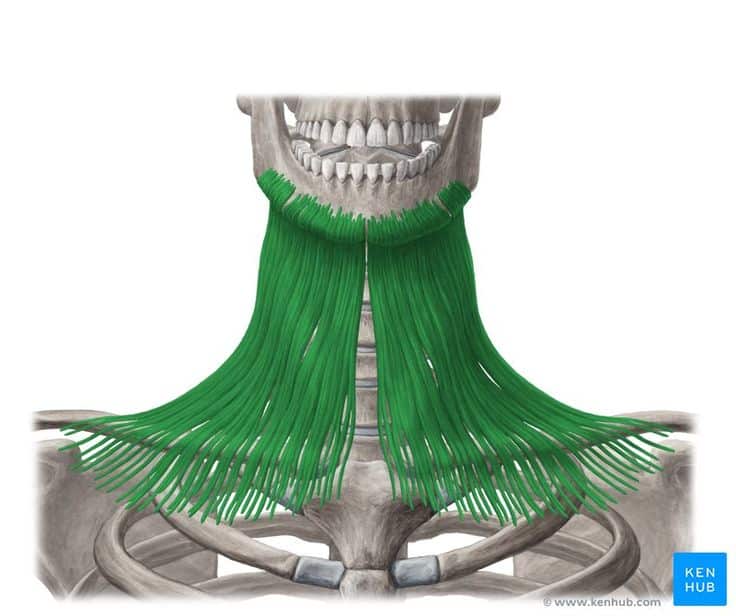
Sternocleidomastoid
The sternocleidomastoid is a long, powerful muscle located on both sides of the neck. It originates from the sternum and clavicle and attaches to the mastoid process of the temporal bone. This muscle assists in the movements of the neck and head.
Innervation: Supplied by the accessory nerve (Cranial Nerve XI).
Functions:
- Rotation of the head to the sides.
- Flexion of the neck forward and to the sides.
- Stabilizing the head and assisting in maintaining proper posture.
This muscle plays a vital role in head and neck movements and is essential for maintaining balance and body coordination. Weakness or injury in this muscle can lead to restricted movement or neck pain.
Image of the Sternocleidomastoid Muscle

2. Deep Anterior Neck Muscles
These muscles lie beneath the superficial structures and play a role in stabilizing the neck and enabling more precise movements.
Longus colli
The longus colli is a deep muscle located in front of the cervical spine. It originates from the cervical vertebrae and some upper thoracic vertebrae, attaching to the transverse processes of other cervical vertebrae. This muscle is composed of three parts: superior, vertical, and inferior.
Innervation: Supplied by cervical spinal nerve branches (C2 to C6).
Functions:
- Flexion of the neck forward (neck flexion).
- Stabilization of the cervical vertebrae.
- Assisting with lateral neck movements and reducing pressure on the spine.
This muscle plays a key role in stabilizing and controlling fine neck movements, and strengthening it can help improve posture and reduce neck pain.
Image of the Longus Colli Muscle
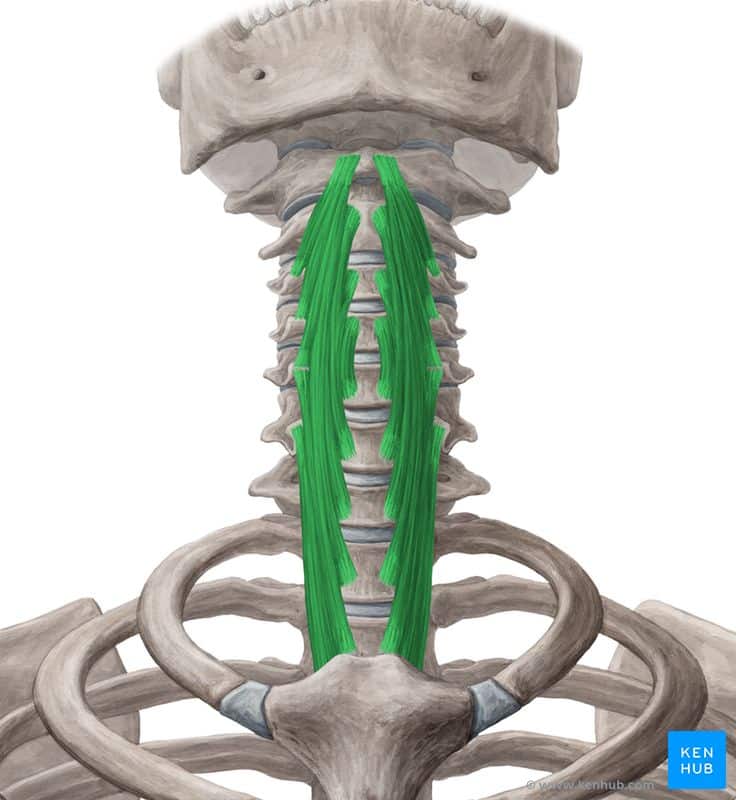
Longus capitis
The longus capitis is a deep muscle located in front of the cervical spine. It originates from the transverse processes of cervical vertebrae C3 to C6 and attaches to the basilar part of the occipital bone. This muscle plays a role in head and neck movements.
Innervation: Supplied by cervical nerve branches (C1 to C3).
Functions:
- Flexion of the head and neck forward.
- Assisting with lateral movements of the head and neck.
- Stabilizing the cervical vertebrae in various positions.
This muscle plays an important role in maintaining posture and reducing neck tension by supporting fine neck movements and stabilizing the head. Strengthening it can help alleviate neck pain and improve neck stability.
Image of the Longus Capitis Muscle
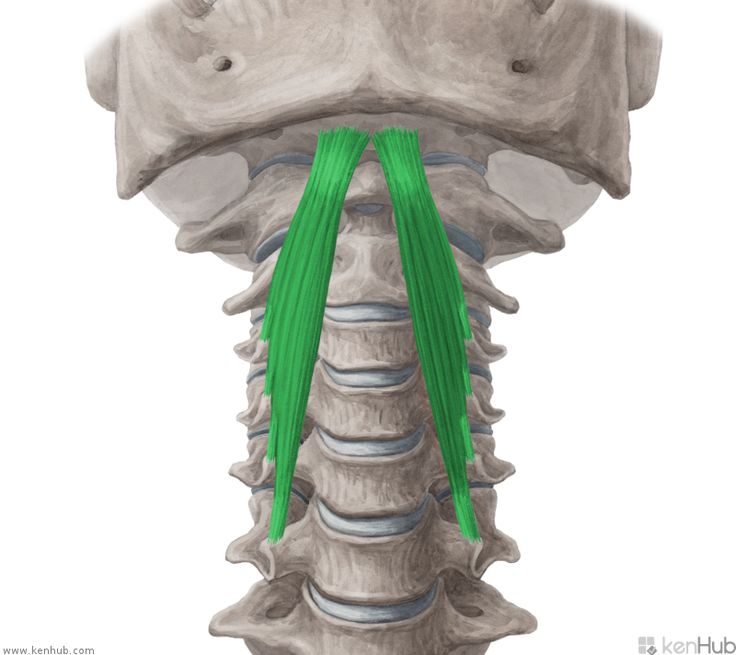
Rectus capitis anterior
The rectus capitis anterior is a small, deep muscle located at the front of the cervical spine near the base of the skull. It originates from the transverse process of the atlas (C1) and attaches to the base of the occipital bone.
Innervation: Supplied by the anterior branches of the cervical spinal nerves (C1 and C2).
Functions:
- Flexion of the head forward.
- Assisting with fine lateral movements of the head.
- Stabilizing the atlanto-occipital joint to maintain balance and skull stability.
This muscle plays a crucial role in small movements and stabilization of the skull, and strengthening or maintaining its health is important for improving neck posture and reducing pain caused by weakness in the deep neck muscles.
Image of the Rectus Capitis Anterior Muscle

Rectus capitis lateralis
The rectus capitis lateralis is a small, deep muscle located on the sides of the cervical spine, playing a role in connecting the head to the neck. It originates from the transverse process of the atlas (C1) and attaches to the inferior surface of the occipital bone.
Innervation: Supplied by the anterior branches of the cervical spinal nerves (C1 and C2).
Functions:
- Lateral flexion of the head (side-to-side head movement).
- Stabilizing the atlanto-occipital joint to maintain head balance.
- Assisting with fine and precise head movements in coordination with neck motions.
This muscle plays an important role in controlled head movements and stability, helping to maintain proper alignment between the head and neck. Weakness or tension in this muscle can lead to impaired neck motion or cause neck pain.
Image of the Rectus Capitis Lateralis Muscle

3. Lateral Neck Muscles
These muscles play a role in lateral neck movements and assist with breathing.
Levator scapulae
The levator scapulae is a deep muscle of the neck and shoulder region that originates from the transverse processes of cervical vertebrae C1 to C4 and attaches to the superior part of the medial border of the scapula.
Innervation:
Supplied by branches of the cervical spinal nerves (C3 and C4) as well as the dorsal scapular nerve originating from the C5 nerve root.
Functions:
- Elevation of the scapula.
- Medial rotation of the scapula, causing the lateral angle to move downward.
- Stabilizing the scapula during arm movements.
- Assisting in flexion and rotation of the neck to one side when the scapula is fixed.
Clinical Importance:
This muscle can become tight or strained in conditions such as poor posture (e.g., prolonged sitting at a desk), which may lead to neck and shoulder pain. It is also involved in syndromes related to neck and upper scapular pain, such as myofascial pain syndrome.
Image of the Levator Scapulae Muscle

Scalene anterior
The anterior scalene is a deep neck muscle that originates from the transverse processes of cervical vertebrae C3 to C6 and attaches to the first rib.
Innervation: Supplied by the anterior branches of the cervical spinal nerves (C4 to C6).
Functions:
- Lateral flexion of the neck and assisting in its rotation.
- Elevation of the first rib during deep inhalation (acting as an accessory muscle of respiration).
- Stabilizing the cervical vertebrae in various positions.
This muscle plays an important role in neck movement and stability and can contribute to conditions such as thoracic outlet syndrome by compressing blood vessels and nerves.
Image of the Anterior Scalene Muscle

Scalene medius
The scalene medius is the largest muscle in the scalene group, originating from the transverse processes of cervical vertebrae C2 to C7 and attaching to the first rib.
Innervation: Supplied by the anterior branches of the cervical spinal nerves (C3 to C8).
Functions:
- Lateral flexion of the neck.
- Elevation of the first rib during deep inhalation (acting as an accessory muscle of respiration).
- Stabilization and support of the neck.
This muscle plays a role in lateral neck movements and breathing and may experience tension or compression in conditions such as thoracic outlet syndrome.
Image of the Scalene Medius Muscle
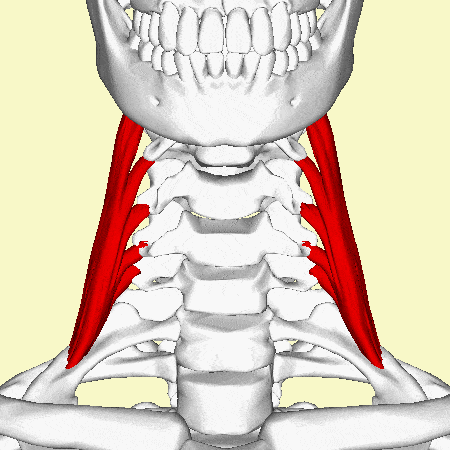
Scalene posterior
The posterior scalene is the smallest muscle in the scalene group. It originates from the transverse processes of cervical vertebrae C4 to C6 and attaches to the outer surface of the second rib.
Innervation: Supplied by the anterior branches of the cervical spinal nerves (C6 to C8).
Functions:
- Lateral flexion of the neck.
- Elevation of the second rib during deep inhalation (acting as an accessory muscle of respiration).
This muscle plays an important role in lateral neck movements and assists in the breathing process, and compared to other scalene muscles, it is less prone to compression or strain.
Image of the Posterior Scalene Muscle

4. Posterior Neck Muscles | Deep and Superficial
These muscles are responsible for rotational movements, extension (backward bending), and stabilization of the head and neck.
Trapezius
The trapezius is a large, superficial muscle located in the back, extending from the base of the skull to the thoracic vertebrae and attaching to the shoulders.
Innervation: Supplied by the accessory nerve (Cranial Nerve XI) and cervical nerve branches (C3 and C4).
Functions:
- Elevation and depression of the shoulders.
- Adduction (retraction) and stabilization of the scapulae.
- Assisting in movements of the neck and head.
This muscle plays a vital role in shoulder and neck movements and contributes to the stability and balance of the upper body.
Image of the Trapezius Muscle

Splenius capitis
The splenius capitis is a superficial muscle located at the back of the neck. It originates from the cervical and upper thoracic vertebrae and attaches to the occipital bone and the mastoid process.
Innervation: Supplied by the dorsal rami of cervical spinal nerves (C3 and C4).
Functions:
- Rotation and lateral flexion of the head.
- Extension of the head and neck.
This muscle plays a key role in rotational movements and extension of the head and neck, helping to maintain balance and alignment of the neck.
Image of the Splenius Capitis Muscle
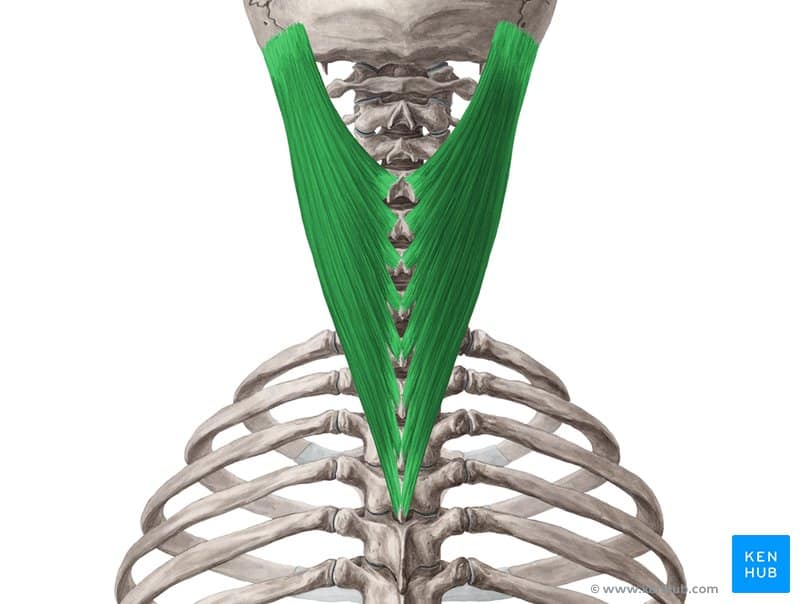
Splenius cervicis
The splenius cervicis is a superficial muscle located at the back of the neck and upper back. It originates from the upper thoracic vertebrae (T3 to T6) and attaches to the transverse processes of cervical vertebrae C1 to C3.
Innervation: Supplied by the dorsal rami of cervical spinal nerves (C4 to C8).
Functions:
- Rotation and lateral flexion of the neck.
- Extension of the neck.
This muscle assists in neck movements and stability and plays a role in coordinating head and neck motions.
Image of the Splenius Cervicis Muscle
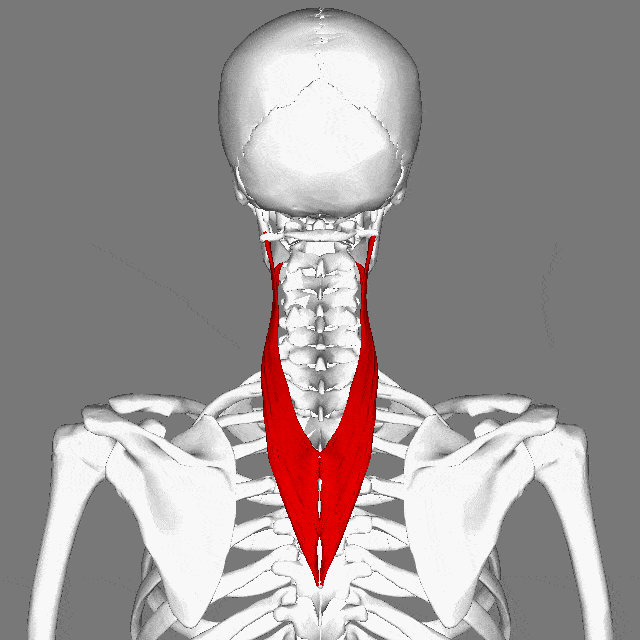
Semispinalis capitis
The semispinalis capitis is a deep muscle located at the back of the neck and upper back. It originates from the transverse processes of cervical and thoracic vertebrae (C4 to T6) and attaches to the posterior surface of the occipital bone.
Innervation: Supplied by the dorsal rami of the cervical spinal nerves.
Functions:
- Extension of the head and neck.
- Assisting with rotation of the head to the sides.
- Stabilizing the cervical vertebrae and maintaining head balance.
This muscle plays a key role in fine movements and stability of the head and neck.
Image of the Semispinalis Capitis Muscle
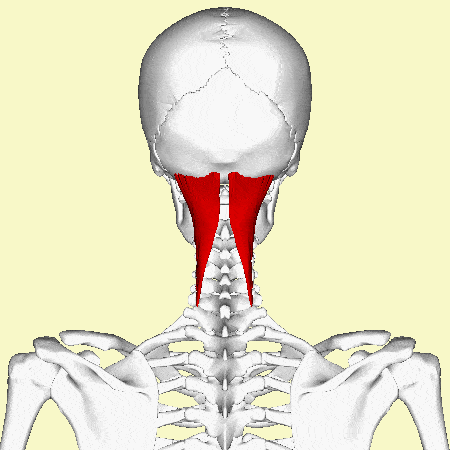
Semispinalis cervicis
The semispinalis cervicis is a deep muscle located at the back of the neck. It originates from the transverse processes of thoracic vertebrae (T1 to T6) and attaches to the spinous processes of cervical vertebrae (C2 to C5).
Innervation: Supplied by the dorsal rami of the spinal nerves.
Functions:
- Extension of the neck.
- Assisting with rotation and lateral flexion of the neck.
- Stabilizing the cervical vertebrae and enhancing neck balance.
This muscle plays a key role in neck movement and stability and helps maintain proper neck posture.
Image of the Semispinalis Cervicis Muscle

Rectus capitis posterior major
The rectus capitis posterior major is a small, deep muscle located at the back of the neck. It originates from the spinous process of the axis (C2) and attaches to the inferior surface of the occipital bone.
Innervation: Supplied by the dorsal ramus of the first cervical spinal nerve (C1 – suboccipital nerve).
Functions:
- Extension of the head.
- Rotation of the head to the sides.
- Assisting in stabilizing the atlanto-occipital joint.
This muscle plays an important role in fine movements and stabilization of the skull, helping to maintain head balance.
Image of the Rectus Capitis Posterior Major Muscle

Rectus capitis posterior minor
The rectus capitis posterior minor is a small, deep muscle located at the back of the neck. It originates from the posterior tubercle of the atlas (C1) and attaches to the inferior surface of the occipital bone.
Innervation: Supplied by the dorsal ramus of the first cervical spinal nerve (C1 – suboccipital nerve).
Functions:
- Extension of the head.
- Assisting with fine head movements.
- Stabilizing the atlanto-occipital joint to maintain skull balance.
This muscle plays an important role in small movements and stabilization of head posture.
Image of the Rectus Capitis Posterior Minor Muscle

Obliquus capitis superior
The obliquus capitis superior is a small, deep muscle located at the back of the neck. It originates from the transverse process of the atlas (C1) and attaches to the inferior surface of the occipital bone.
Innervation: Supplied by the dorsal ramus of the first cervical spinal nerve (C1 – suboccipital nerve).
Functions:
- Lateral flexion of the head.
- Assisting with extension of the head.
- Stabilizing the atlanto-occipital joint to maintain skull balance.
This muscle plays a role in fine movements and stability of the head and is part of the suboccipital muscle group.
Image of the Obliquus Capitis Superior Muscle
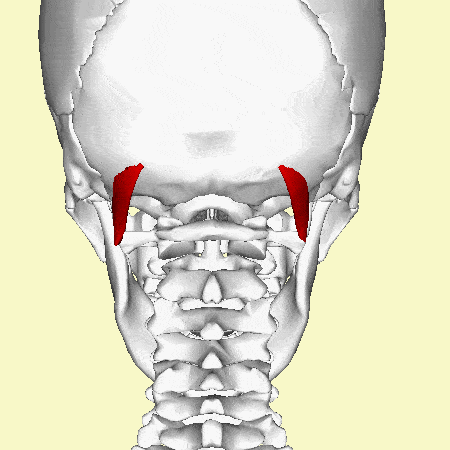
Obliquus capitis inferior
The obliquus capitis inferior is a small but strong muscle located at the back of the neck. It originates from the spinous process of the axis (C2) and attaches to the transverse process of the atlas (C1).
Innervation: Supplied by the dorsal ramus of the first cervical spinal nerve (C1 – suboccipital nerve).
Functions:
- Rotation of the head to the sides (by rotating the atlas vertebra).
- Stabilizing the atlas and axis vertebrae.
- Assisting with fine movements and maintaining skull balance.
This muscle is the only suboccipital muscle that does not attach to the occipital bone, and its primary role is in head rotation.
Image of the Obliquus Capitis Inferior Muscle

5. Muscles Attached to the Hyoid Bone
These muscles play a role in swallowing and neck stabilization and are divided into two groups.
Suprahyoid Muscles
Mylohyoid
The mylohyoid is a thin, broad muscle forming the floor of the mouth. It originates from the inner surface of the mandible and attaches to the hyoid bone.
Innervation: Supplied by the mylohyoid nerve, a branch of the inferior alveolar nerve originating from the trigeminal nerve (cranial nerve V).
Functions:
- Elevating the floor of the mouth and tongue during swallowing and speaking.
- Assisting in lowering the mandible (jaw).
- Stabilizing the hyoid bone.
This muscle plays an important role in swallowing, chewing, and tongue movements, forming the floor of the mouth.
Image of the Mylohyoid Muscle
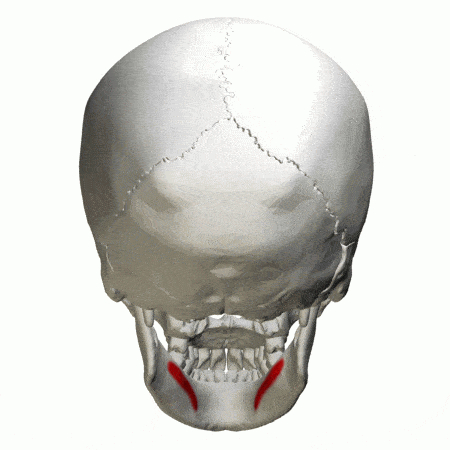
Geniohyoid
The geniohyoid is a small, narrow muscle located in the floor of the mouth. It originates from the mental spines on the inner surface of the mandible and attaches to the hyoid bone.
Innervation: Supplied by a branch of the hypoglossal nerve (Cranial Nerve XII) originating from C1.
Functions:
- Elevating the hyoid bone during swallowing.
- Assisting in lowering the mandible (jaw).
- Pulling the hyoid bone forward to facilitate tongue and mouth movements.
This muscle plays an important role in swallowing and stabilizing the hyoid bone, contributing to oral and pharyngeal functions.
Image of the Geniohyoid Muscle
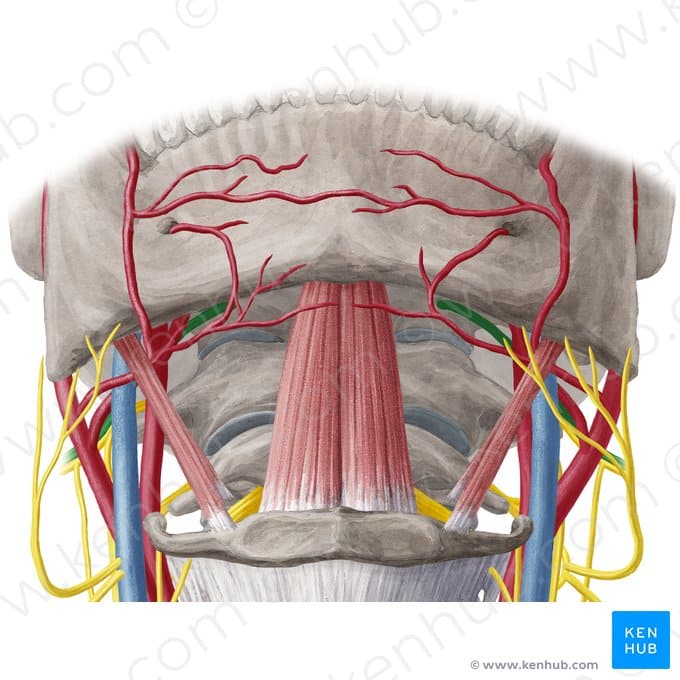
Stylohyoid
The stylohyoid is a thin, long muscle that originates from the styloid process of the temporal bone and attaches to the hyoid bone.
Innervation: Supplied by a branch of the facial nerve (Cranial Nerve VII).
Functions:
- Elevating and retracting the hyoid bone.
- Assisting in swallowing by elevating the floor of the mouth and stabilizing the hyoid bone.
This muscle plays a key role in the swallowing process and stabilization of the hyoid bone, working in coordination with other suprahyoid muscles.
Image of the Stylohyoid Muscle

Digastric
The digastric is a two-bellied muscle consisting of an anterior and a posterior belly, connected to the hyoid bone by an intermediate tendon.
Origin and insertion:
- The posterior belly originates from the mastoid process of the temporal bone.
- Anterior belly: originates from the inner surface of the mandible.
- Both bellies attach to the hyoid bone.
Innervation:
- Anterior belly: innervated by the mylohyoid nerve, a branch of the trigeminal nerve (cranial nerve V).
- Posterior belly: innervated by a branch of the facial nerve (cranial nerve VII).
Functions:
- Elevating the hyoid bone during swallowing and speech.
- Depressing the mandible to open the mouth.
This muscle plays a vital role in swallowing, speech, and movements of the lower jaw.
Image of the digastric muscle
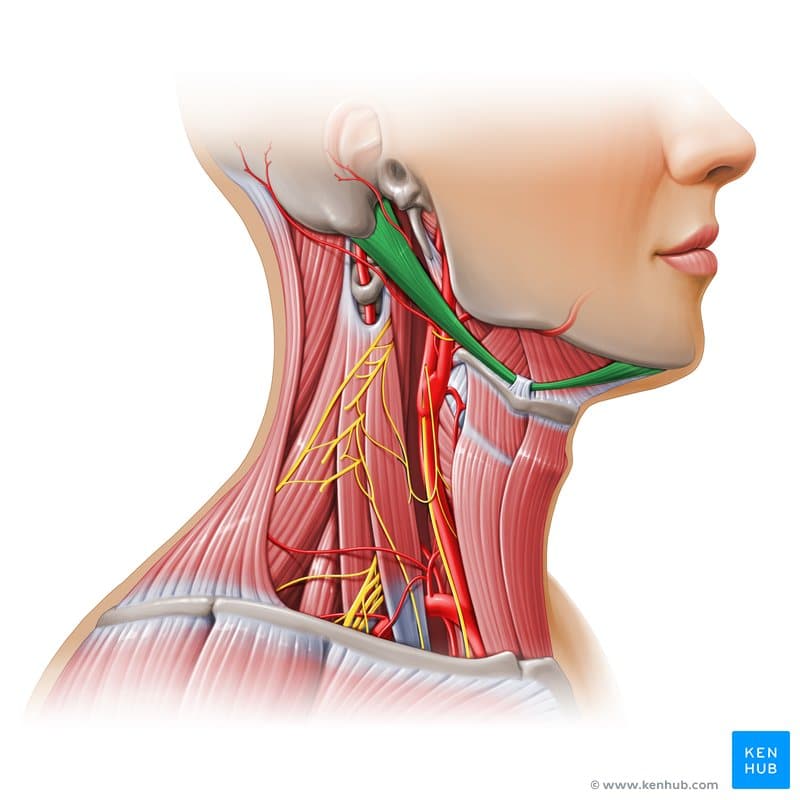
Infrahyoid muscles
Sternohyoid
The sternohyoid is a long, superficial muscle in the neck that originates from the sternum and attaches to the hyoid bone.
Innervation: by branches of the cervical nerves (C1 to C3) through the ansa cervicalis.
Functions:
- Depresses the hyoid bone after swallowing.
- Stabilizes the hyoid bone for the movements of other neck and jaw muscles.
This muscle is part of the infrahyoid muscles and plays a role in positioning the hyoid bone and assisting swallowing movements.
Image of the sternohyoid muscle
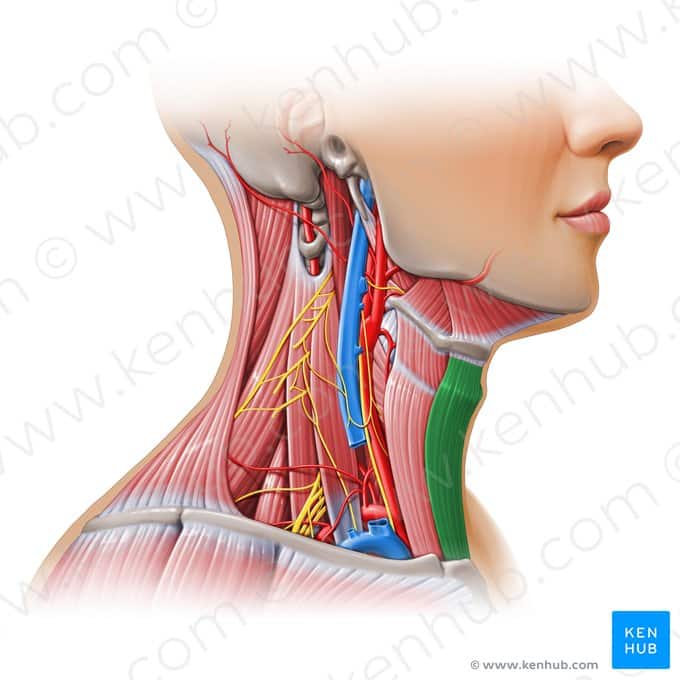
Omohyoid
The omohyoid is a long, thin muscle from the infrahyoid group that consists of two parts (superior and inferior bellies) connected by an intermediate tendon.
Origin and insertion:
- Inferior belly: originates from the superior border of the scapula.
- Superior belly: attaches to the hyoid bone.
Innervation: by cervical nerve branches (C1 to C3) via the ansa cervicalis.
Functions:
- Depresses the hyoid bone.
- Stabilizes and adjusts the position of the hyoid bone for swallowing and speech functions.
- Assists in reducing pressure on deep neck structures by tensioning the fascia.
This muscle contributes to the balance and fine movements of the neck and hyoid bone.
Image of the omohyoid muscle
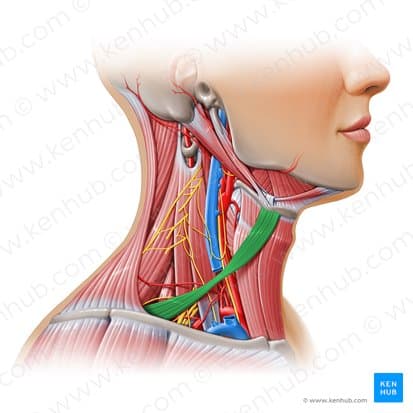
Sternothyroid
The sternothyroid is a long, deep muscle in the infrahyoid group that originates from the sternum and attaches to the thyroid cartilage.
Innervation: by cervical nerve branches (C1 to C3) via the ansa cervicalis.
Functions:
- Depresses the thyroid cartilage.
- Assists in positioning and stabilizing the laryngeal structures during swallowing and speech.
This muscle plays an important role in the movement and stability of the larynx and works in coordination with other infrahyoid muscles.
Image of the sternothyroid muscle
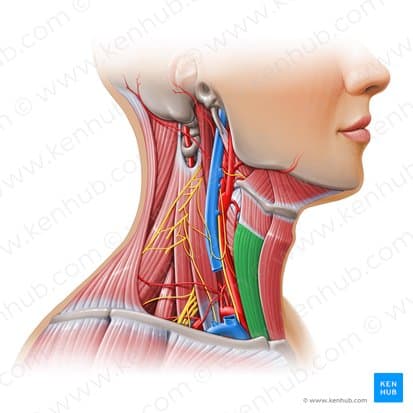
Thyrohyoid
The thyrohyoid is a short, deep muscle in the infrahyoid group that originates from the thyroid cartilage and attaches to the hyoid bone.
Innervation: by the C1 nerve branch, which is carried via the hypoglossal nerve (cranial nerve XII).
Functions:
- Depresses the hyoid bone.
- Elevates the thyroid cartilage during swallowing and speech.
This muscle plays a key role in regulating laryngeal movements and stabilizing the hyoid bone.
Image of the thyrohyoid muscle

The effect of exercise on strengthening neck muscles
Increased muscle strength and endurance
Regular exercise strengthens the neck muscles, enabling them to better support the weight of the head and protect sensitive structures such as vertebrae, discs, and nerves. This added strength and endurance help prevent fatigue and injuries caused by repetitive movements or sudden stresses.
Improved flexibility and range of motion
Exercise movements help stretch and increase the flexibility of neck muscles. This leads to improved range of motion of the head and neck and prevents movement limitations caused by muscle stiffness or tightness.
Prevention and reduction of neck pain
Strengthening and stretching exercises can reduce muscle tension and relieve excessive pressure on the cervical vertebrae and discs. This is especially beneficial for individuals experiencing neck pain caused by poor posture or repetitive activities.
Improved posture
Neck exercises help stabilize and strengthen the deep muscles that play a crucial role in maintaining balance and alignment of the cervical spine. This can lead to improved posture and prevent issues such as forward head posture or rounded shoulders.
Increased stability and balance
The neck muscles play a vital role in head stability and overall body balance. Exercises targeting this area improve coordination between the neck, shoulder, and spinal muscles, reducing the risk of injury—especially for athletes and individuals engaged in intense physical activities.
Supporting mental health and reducing stress
Neck stretching exercises can relieve tension and pressure in the muscles of this area, promoting a sense of relaxation and comfort. This helps reduce both physical and mental stress.
Conclusion
Neck exercises and movements are not only essential for increasing the strength and function of neck muscles but also contribute to improving quality of life, reducing injuries, and preventing common neck problems. Performing these exercises regularly and with proper technique significantly enhances their positive effects.
Common injuries and disorders
Whiplash
Whiplash is a neck injury that typically occurs due to a sudden, forceful movement of the head forward and then backward. This injury is commonly seen in car accidents, especially rear-end collisions.
Characteristics:
- It includes strains or tears of the muscles, ligaments, and soft tissues of the neck.
- It may cause neck pain, reduced range of motion, headaches, dizziness, and sometimes symptoms such as shoulder or arm pain.
Treatment:
- Rest, physical therapy, stretching and strengthening exercises, and in severe cases, anti-inflammatory medications or pain relievers.
Whiplash typically improves with appropriate treatment, but in some cases, it can lead to long-term complications.
Image of whiplash injury

Neck muscle spasms
Neck muscle spasm is a condition in which the neck muscles contract suddenly or continuously, causing pain, limited movement, and sometimes headaches.
Common causes:
- Poor posture (such as prolonged sitting).
- Stress or psychological tension.
- Minor injuries or muscle strains.
- Sleeping in an improper position.
- Neck-related disorders, such as cervical disc problems.
Treatment:
- Rest and use of warm or cold compresses.
- Stretching exercises and massage.
- Use of pain relievers or anti-inflammatory medications in severe cases.
Prevention is possible by maintaining proper posture and performing neck exercises.
Image of muscle spasm
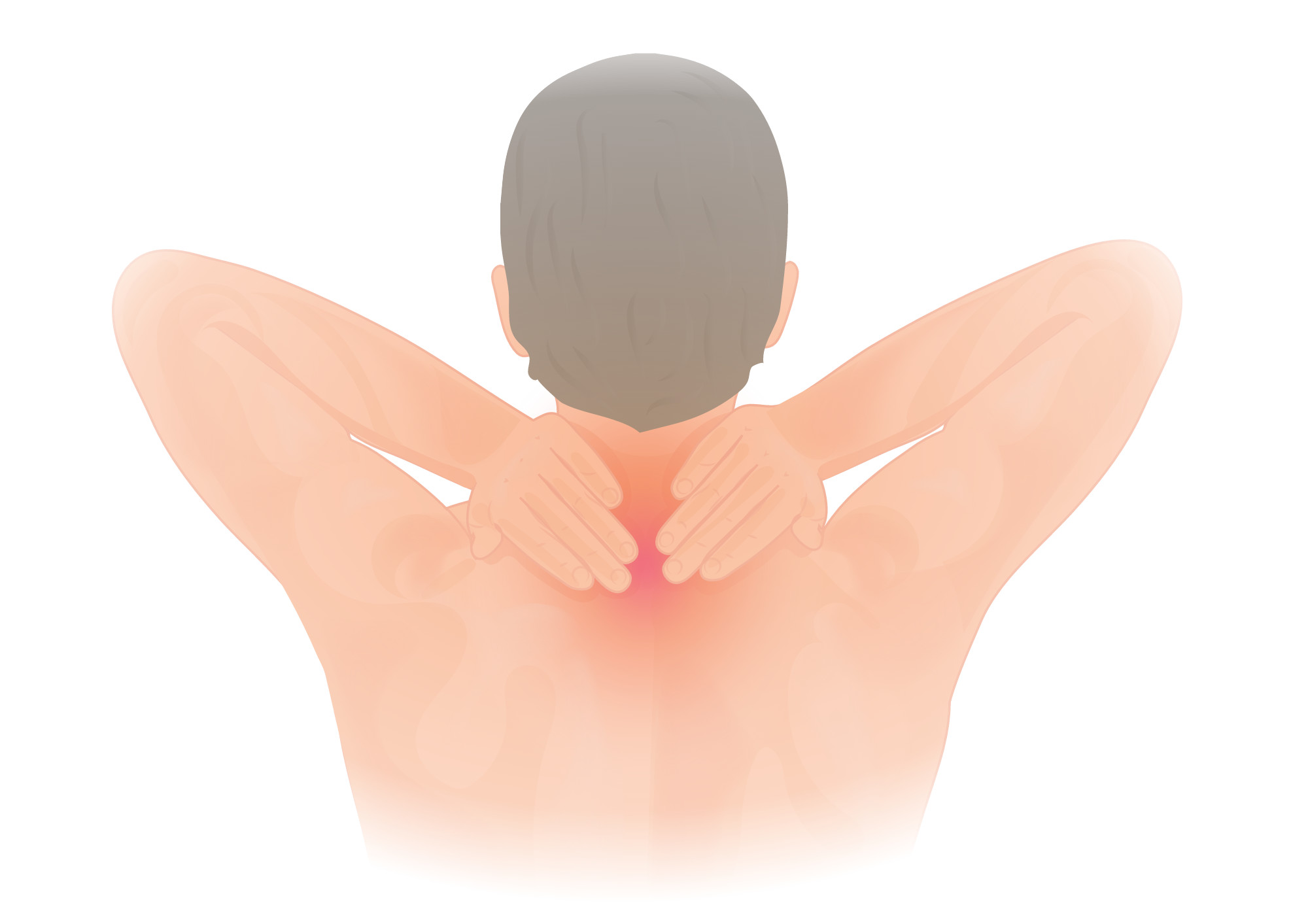
Cervical Disc
The cervical disc refers to the intervertebral discs in the neck, located between the cervical vertebrae (C1 to C7). These discs consist of an outer fibrous ring (annulus fibrosus) and an inner gel-like core (nucleus pulposus), which help absorb shock and maintain neck flexibility.
Common cervical disc problems:
- Cervical disc herniation: protrusion or rupture of the disc that may put pressure on the spinal nerves.
- Cervical Disc Degeneration: The deterioration and decreased function of the disc due to aging or injury.
Symptoms:
- Neck pain.
- Numbness or weakness in the arms and hands.
- Reduced range of motion.
Treatment:
Ranges from rest and physical therapy to surgery in severe cases, depending on the severity of the condition.
Image of the cervical disc
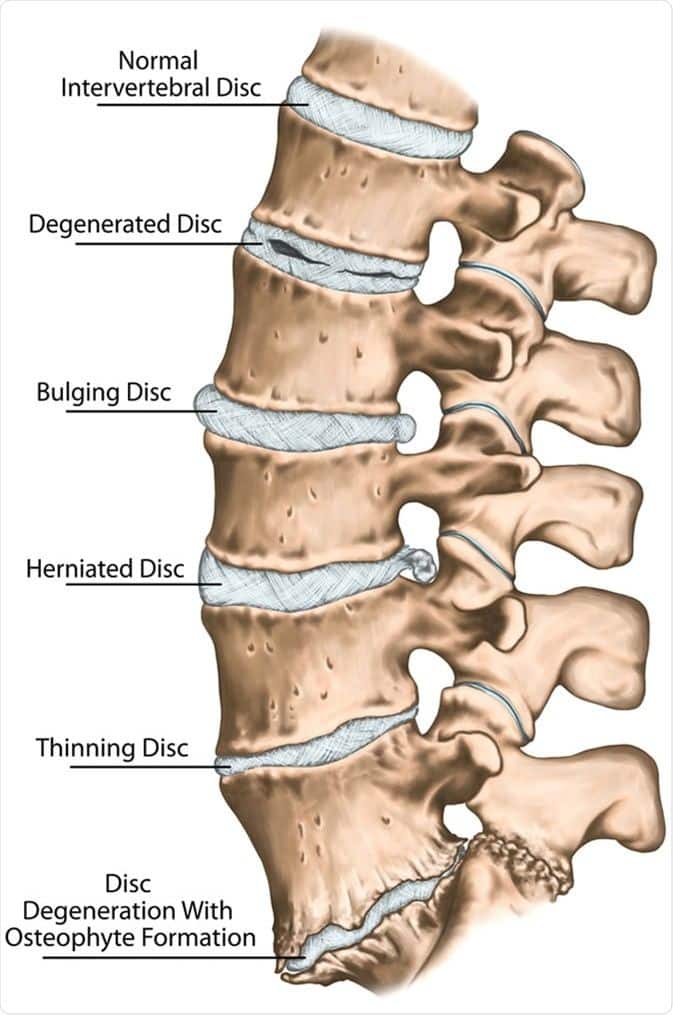
Cervical Osteoarthritis
Cervical Osteoarthritis or Cervical Spondylosis refers to the degeneration and wear of the joints, discs, and bones of the cervical spine. This condition usually occurs due to aging or gradual wear and tear of the vertebrae and discs.
Symptoms:
- Neck pain and stiffness.
- Reduced range of motion.
- Headache (usually at the back of the head).
- Sometimes numbness or weakness in the arms and hands.
Causes:
- Disc degeneration.
- Bone spur growth.
- Stiffness and reduced flexibility of the ligaments.
Treatment:
- Pain management with medication and physical therapy.
- Strengthening and stretching exercises.
- Surgery in severe cases.
This condition is usually chronic, but with proper care, the symptoms can be managed.
Image of cervical osteoarthritis

Rehabilitation and Treatment Methods
Physical therapy: Focuses on corrective and strengthening exercises to restore normal muscle function.
Massage therapy: This method helps reduce muscle tension, increase blood circulation, and improve flexibility.
Therapeutic injections: Such as corticosteroid injections to reduce inflammation in severe cases.
Use of braces: Cervical braces help stabilize the neck and reduce excessive movement during injury.
Rehabilitation exercises: These exercises are designed to gradually restore muscle function.
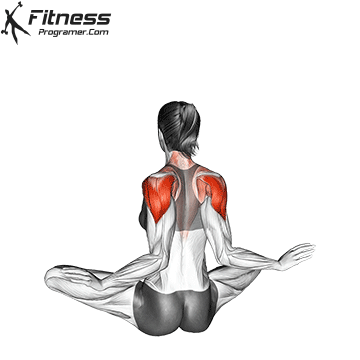
Interesting and Practical Facts
- The neck muscles support more than 20% of the head’s weight, highlighting their strength and stability.
- Poor posture can place significant strain on the neck muscles, especially when using electronic devices.
- Regular stretching and strengthening exercises can help prevent many injuries.
- Drinking enough water is essential for maintaining muscle flexibility and preventing cramps.

Conclusion
The neck muscles play a key role in maintaining body function, preventing injuries, and improving quality of life. Given the complexity and importance of these muscles, understanding their structure, function, and care methods can enhance both quality of life and athletic performance. Regular exercise, maintaining proper posture, and injury prevention are among the most important measures to strengthen these vital muscles.

References
Anatomy and medical books :
Gray's Anatomy (one of the standard references in anatomy)
Netter's Atlas of Human Anatomy (a well-known illustrated atlas in anatomy)
Clinically Oriented Anatomy by Keith Moore
Sports and training references :
Strength Training Anatomy by Frederic Delavier
Essentials of Strength Training and Conditioning by NSCA
Well-known articles and training programs by international coaches
Medical databases :
PubMed (for scientific and research articles)
MedlinePlus (health and medical information)
WebMD (for practical and general health information)
Specialized sports and health websites :
Images used:
(Kenhub) kenhub.com
Further Reading
Pelank Life | Body Health Assessment
The Best Body Health Calculators Using Scientific Methods
Developed by Pelank Life ©